

William Stopford
Ford Everest recalled
1 Day Ago
Hyundai's flagship SUV in Australia has a distinctly American flavour. With eight seats and acres of space, fares well against established rivals.



Marketplace Editor

Marketplace Editor


Marketplace Editor

Marketplace Editor
Quickly see how this car stacks up against its competition. Select any benchmark to see more details.
Where expert car reviews meet expert car buying – CarExpert gives you trusted advice, personalised service and real savings on your next new car.
Australia is a hot pot of different tastes, and from an automotive perspective we seem to be a weird hybrid of the American and European markets.
That’s how we end up with vehicles like the Hyundai Palisade – an American-styled, large SUV with up to eight seats and a big V6 petrol engine up front – alongside the brand’s smaller, more Euro-flavoured offerings.
While the big family SUV is not a new concept, Aussie families have been flocking to big, seven-seat crossovers in droves since the Ford Territory popularised the format Down Under nearly two decades ago.

Originally revealed at the 2018 Los Angeles motor show, the big Hyundai was primarily focused on the North American market as a contender for the likes of the Mazda CX-9 and Toyota Kluger – themselves American-focused offerings.
A couple years later after much lobbying by Hyundai Australia, the bosses in South Korea have green-lit a right-hand drive version for Australia and New Zealand – no mean feat when you consider our market size compared to the US.
We spent most of our time in the diesel all-wheel drive version at launch, so here we’re testing the entry-level ‘Palisade’ trim with the petrol V6 and front-wheel drive.
Just two trim levels and two engine variants are available for the Palisade in Australia, and the vehicle on test is the entry point to the line-up priced from $60,000 before on-road costs – or a little over $65,000 drive-away in Victoria.
Should you want a diesel motor up front and all-wheel drive in the same trim level, that bumps the ticket up to $64,000 plus on-roads.
The range then extends to the flagship Highlander, which starts at $71,000 for the V6 FWD and $75,000 for the diesel AWD.
In entry guise the Palisade is competing with mid- and high-spec large SUVs like the Mazda CX-9 GT FWD ($62,990), and soon-to-be-replaced Toyota Kluger GXL (from $54,950).

There’s also competition from within the Hyundai stable. One can purchase the smaller seven-seat Santa Fe in flagship Highlander trim for $61,700 before on-roads with a petrol V6 and front-wheel drive.
The Kia Sorento GT-Line is available with the same drivetrain for $63,290 drive-away.
What the Palisade offers above and beyond all its competitors is space. In fact, its unique eight-seat layout in the large SUV class in Australia puts it in contention with an unlikely platform-mate, the Kia Carnival.
Kia’s popular people mover can be had with eight seats, as well with a petrol V6 with front-wheel drive. Like the Santa Fe and Sorento, the $60,000 bracket sees the Carnival enter in flagship Platinum trim, priced at $67,990 drive-away.

Buy your new car without the stress. It's fast, simple and completely free.

Great service from Travis and team, second time I have used this business would not hesitate to recommend them to anyone
Craig C.
Purchased a Ford Ranger in Sunshine Coast, QLD
CarExpert helped Craig save $7,224 on his Ford Ranger, now let us save you on your next new car.
Get your BEST priceDespite being billed as the ‘entry-level’ variant, the base Palisade comes with quite a bit of standard kit, including:

There are a few omissions to tempt you into the Highlander grade, though.
For starters, there’s no LED headlights (projector-type halogens instead), no automatic wipers (really?!), no wireless phone charger, no powered tailgate, and no heating for the front seats.
There’s also no Blind Spot View monitor in the instrument cluster like the flagship grade, nor is the swish 12.3-inch digital driver’s binnacle available locally in any trim level like it is in South Korea and the United States.
It’s otherwise pretty well equipped relative to its competition, and has wow-factor when you consider the bold design that certainly turns heads.

Standard safety equipment in all Australian-market Palisade models includes:

Moving to the range-topping Palisade Highlander brings a blind-spot view monitor, allowing owners to see a camera feed of their blind-spot in the instrument binnacle.
Given it isn’t sold in Europe, the Palisade hasn’t been crash-tested by Euro NCAP prior to its release in Australia, nor has local firm ANCAP tested it either.
It’s unclear whether the crash-testing body plans to put the Palisade through its paces, though given it doesn’t offer features like a front-centre airbag or junction AEB, it wouldn’t satisfy the criteria for a 2021-stamped five-star rating.
With that being said, the US’s IIHS awarded the Palisade a ‘Top Safety Pick’ rating in 2020 based on tests conducted on the virtually identical Kia Telluride, scoring top marks across almost all criteria bar the base model’s headlights and the ease-of-use for child seat anchor points.

The Palisade ushered in a new direction for Hyundai in terms of interior design, blending a refined and upmarket layout with high-quality materials and touch points.
Even a couple of years since its debut, the Palisade’s cabin feels quite fresh compared to older rivals (think Kluger and Pathfinder), though the latest Santa Fe has refined this design even more with more padded and soft-touch surfaces low down in the cabin. But I digress…
There’s oodles of space up front and all the major controls fall within reach. Hyundai has done a good job at converting the Palisade for right-hand drive.



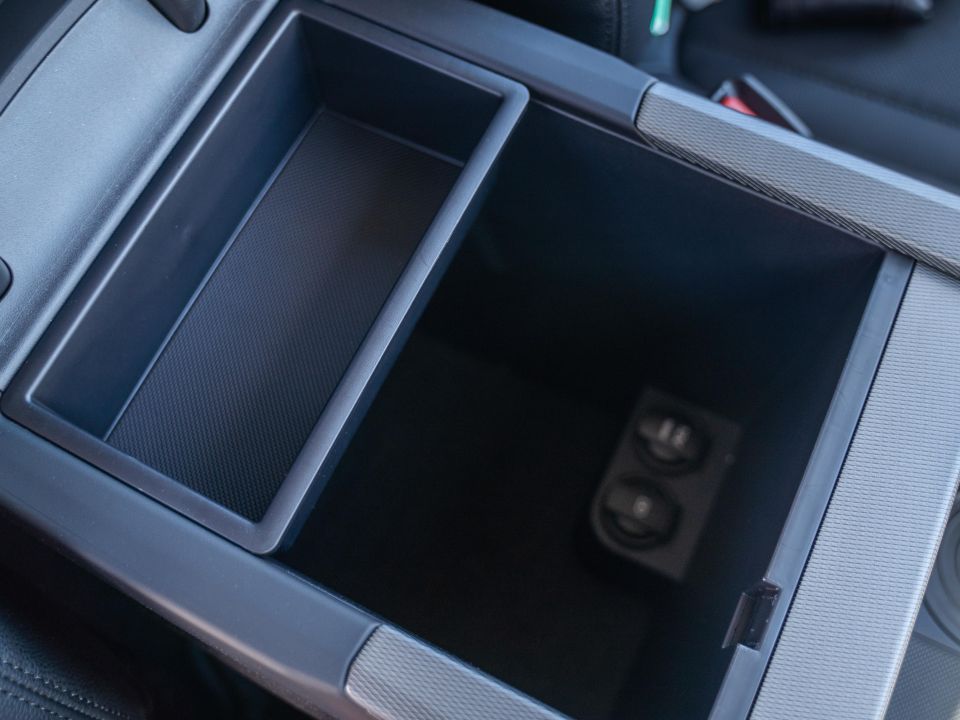
Your attention is quickly drawn to the leather-trimmed steering wheel, the shift-by-wire selector, and 10.25-inch widescreen touch display featuring inbuilt satellite navigation, as well as wired Apple CarPlay and Android Auto.
On the topic of the latter, it performs as well as any other display in high-end Hyundai models because it’s basically the same. The latest Hyundai/Kia software interface builds on the most recent iteration with attractive graphics, quick load times and simple menus.
The standard 12-speaker Infinity audio system is likewise quite good, offering deep, clear sound with the option to really turn up the bass and turn the Palisade into something of a miniature party bus.
We did, however, receive numerous complaints from people on the other side of the phone when using Apple CarPlay. The audio was reported to be echoey and muffled, not great when you consider the price of this car.




Wireless smartphone charging would be nice, but after my recent experiences with buggy wireless smartphone mirroring I was relieved to have a reliable, wired connection for Apple CarPlay. It worked flawlessly, as it should.
Storage is abundant in the first row as well. A large, modular centre console houses swivelling cupholders and space for your phone and wallet, while the front centre armrest covers a deep bin with removable tray.
There’s also a hidey hole underneath the centre console that can fit a small bag or similar out of view with two additional 12V power outlets, though the door bins are too small for my liking – my Golf has more storage in the lower door.
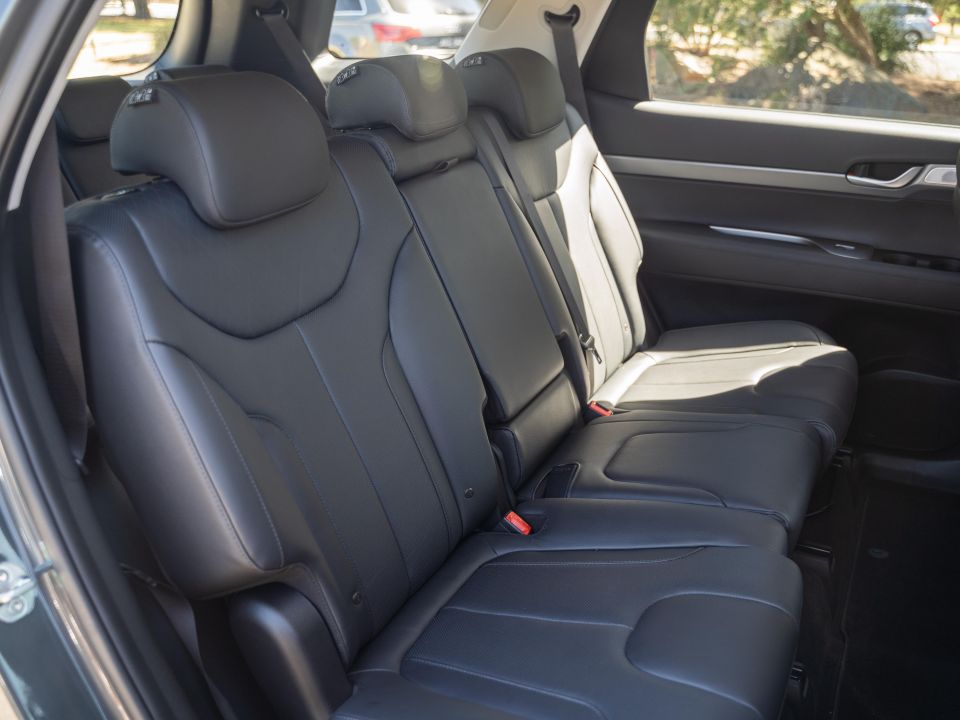
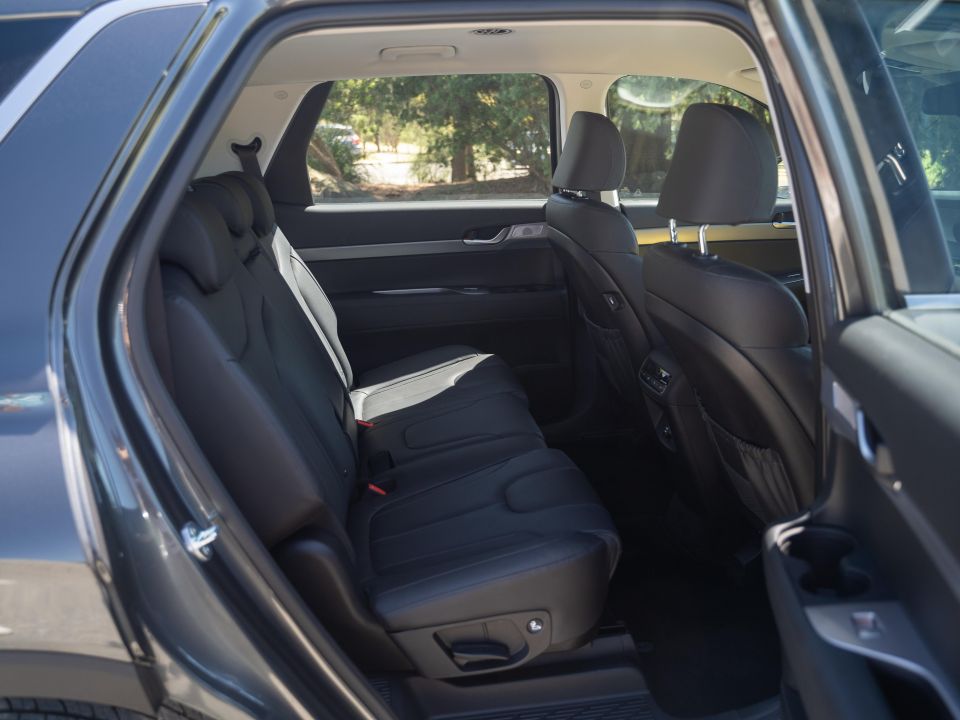


In the second row, occupants are pretty well catered for. There’s enough room for three adults to sit across, with heaps of leg- and headroom in all three positions.
Amenities are plentiful as well. There’s a third zone of climate controls for the second and third rows, with a temperature control panel at the rear of the centre console and roof-mounted air vents for both rear rows of seating.
There’s another 12V power outlet lower down, and there’s USB-A outlets mounted on the sides of the front seats. Your iPads will never go flat.
Bottle holders in the doors, a fold-down centre armrest with cupholders, and ISOFIX mounts on the outer positions with three top-tether points complete the second-row features.
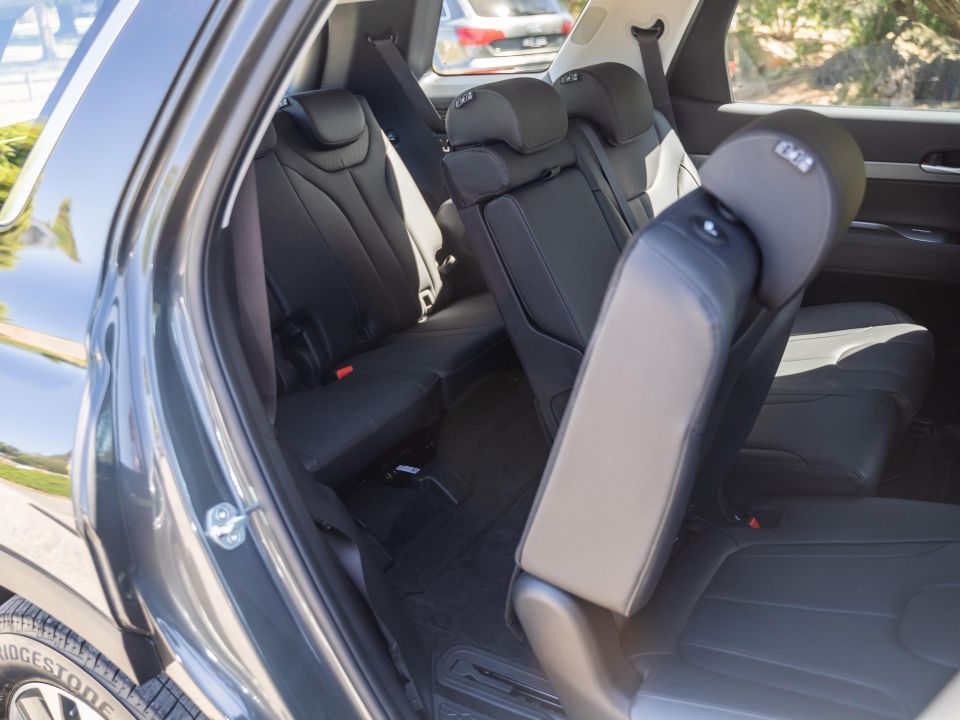

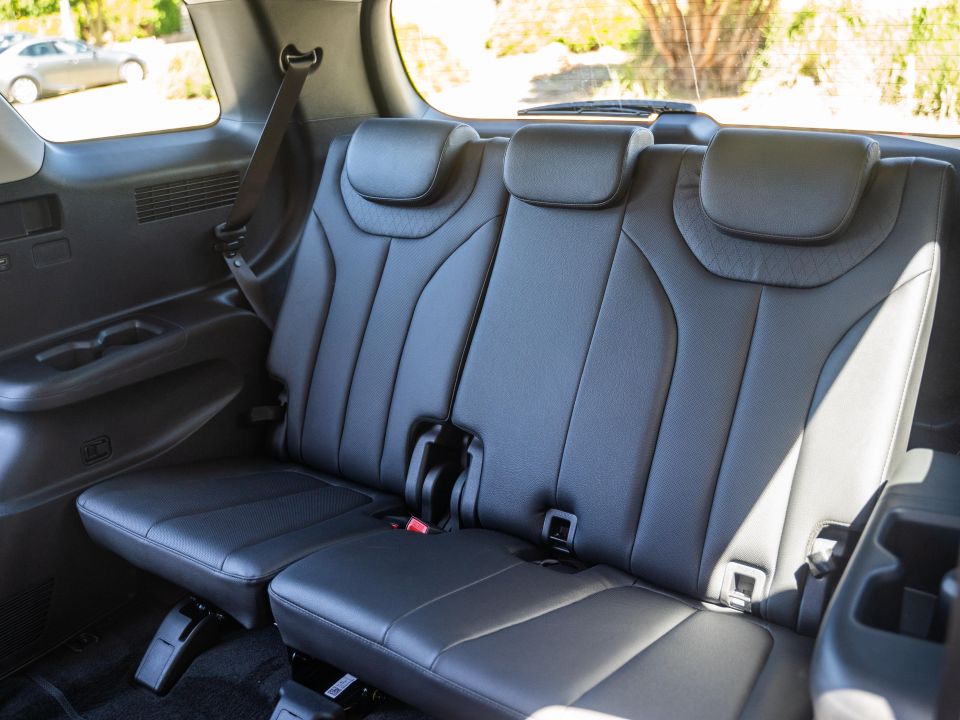



The third row is accessed by folding and sliding the second row forward, toggled by a powered mechanism for easier access.
An additional ISOFIX mount is found on the kerb-side seat in the third row, and unlike any other vehicle in the segment there’s another three seats. Top-tether points across two of the three positions is another highlight.
Unlike the second row, the third-row centre seat is best left for kids, as it’s super narrow and the outer pews are pushed in due to the armrests and wheel arches.
However, should you ever need to transport seven kids, the Palisade will carry them more comfortably than any competitor. There’s more USB points and squared-off cupholders on both sides, too.
At six-foot-one and a bit, I was surprised that I could fit in the third row (just), meaning you can actually squeeze a couple of larger adults in there for a short to medium journey. The Palisade also has curtain airbags that fully cover the third row, a point of criticism for its Santa Fe stablemate.
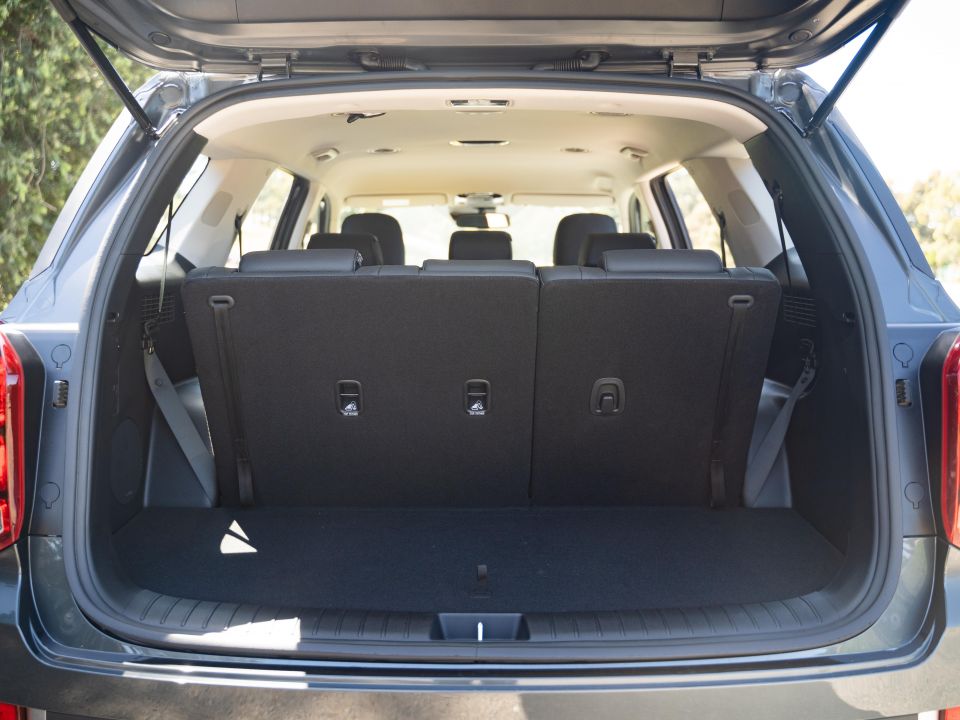





Behind the third row, there’s 311L of cargo capacity with all seats in play. With the rearmost row folded, Hyundai quotes 704L.
If you fold the second and third rows of seats down (the second row can be released remotely from the luggage area), it opens up a huge area that’s both flat and quite long.
Hyundai doesn’t quote a figure for when the Palisade is in two-seat configuration, but it’ll easily swallow bikes, skis, and furniture.
You’ll notice the tailgate is disappointingly lacking power assistance like the Highlander, though the rear door is pretty light and easy to open/close.
There’s some under-floor storage as well behind the third row, giving you a place to store the cargo cover (very clever) and any other small items. Hyundai also equips the Palisade with a full-size spare wheel.
While the Palisade is impressive in terms of its practicality within context of the large SUV set, it still can’t beat its Carnival stablemate for outright people- and luggage-carrying capacity.

Where expert car reviews meet expert car buying – CarExpert gives you trusted advice, personalised service and real savings on your next new car.
The vehicle we have on test is powered by a 3.8-litre naturally-aspirated V6 petrol engine driving the front wheels via an eight-speed automatic transmission.
Outputs are quoted as 217kW (at 6000rpm) and 355Nm (at 5200rpm), while fuel use is rated at 10.7L/100km on the combined cycle. We ended our week-long loan with an indicated 11.1L/100km over 500 kilometres of mixed driving.
Due to packaging issues for right-hand drive models, as also quoted for the related Hyundai Santa Fe and Kia Sorento, there’s no all-wheel drive option for petrol V6 models like in left-hook Korea and North America.

If you want all-paw traction you need to shell out an additional $5000 for the 2.2-litre four-cylinder turbo-diesel in otherwise identical specification. The oiler offers 147kW at 3800rpm and 440Nm between 1750 and 2750rpm.
In addition to the extra torque, the diesel is far thriftier, at least officially, using 7.3L/100km on the combined cycle.
The petrol V6 will happily run on cheaper 91RON regular unleaded, and the fuel tank measures 71L for all versions. Unlike North American and Korean models, none of the Palisade engines in Australia get fuel-saving idle start/stop tech.

I was quite interested to have a drive of the Palisade given it’s one of the few Hyundai/Kia models that hasn’t been subjected to the local suspension tuning program.
On the topic of the ride and handling first up, the big Hyundai proves local tuning isn’t always required. The comfort-focused suspension is a great fit for the vehicle’s character and strikes a good balance between ride comfort and handling competence.
It wafts along in the city and on the open road, gliding over imperfections without breaking a sweat – and that’s with standard steel-sprung suspension.
The steering is quite light and doesn’t offer a whole lot of feedback, but it’s pretty accurate and direct making the Palisade a surprisingly easy steer given its hefty dimensions – at 4980mm long, 1975mm wide and 1897kg, it’s a big bus.
What you don’t get is the sense of athleticism or sportiness like you might in the Mazda CX-9 or a premium European alternative like the Audi Q7, though to call the standard Q7 overtly sporty is a bit of a stretch.

The Palisade feels like a big, comfy, Americanised SUV. That’s no bad thing, because it does what it needs to by transporting you and all your passengers in pretty decent comfort.
The 3.8-litre naturally-aspirated V6 we had on test is a gem of an engine. It’s silky smooth, has a lovely note, and is more than a match for similar powertrains in the segment.
In concert with Hyundai’s excellent eight-speed torque converter automatic, the Palisade offers ample performance in petrol guise, and you’ll rarely light up the front tyres in this two-wheel drive version unless you go full throttle in the wet – which is usually unecessary.
Like the suspension and steering tunes, the drivetrain suits the Palisade’s vibe well. It’s smooth, relaxed and refined regardless of whether you’re in the ‘burbs or eating up miles on the highway.
With that in mind, I swapped out of the base petrol into a Highlander diesel at the end of our loan, and found the torquey, refined character of the four-cylinder oiler to be a better fit for the Palisade.

The petrol has a habit of shuffling through gears regularly as it’s a little lean on low-down torque – 355Nm at 5500rpm compared to the diesel’s 440Nm from just 1750rpm. It’s also pretty thirsty in real-world driving as I couldn’t get the trip computer under 10.0L/100km unless it was exclusively driven on the freeway.
Cabin refinement is pretty good across most environments, with good suppression from wind and tyre noise even over rougher road surfaces. That said, it isn’t quite as hushed at speed as the CX-9.
We found the bulk of the Hyundai’s driver assist systems to be some of the better calibrated in the business too. The lane-centring function wasn’t as invasive as some other systems we’ve sampled, and the adaptive cruise control was very human-like in operation.
Standard blind-spot monitoring and rear cross-traffic alert are a big help with a vehicle this long, and the basic reversing camera is pretty good quality – though the Highlander’s surround-view monitor is a big step up given the dimensions.
While we knocked the standard projector-type halogen headlights earlier, the base model’s headlight offer decent illumination given the bulb-type, and the auto high-beam function likewise performs well.

The Palisade is covered by Hyundai Australia’s five-year, unlimited-kilometre new vehicle warranty with roadside assistance for the same period and lifetime capped-price servicing.
Maintenance is required every 12 months or 15,000km with the first five services costing $399 a pop for V6 models, and $469 for the diesel.
In V6 petrol guise, the Palisade will set you back $1995 for the first 60 months/75,000km in servicing.

Buy your new car without the stress. It's fast, simple and completely free.

Great service from Travis and team, second time I have used this business would not hesitate to recommend them to anyone
Craig C.
Purchased a Ford Ranger in Sunshine Coast, QLD
CarExpert helped Craig save $7,224 on his Ford Ranger, now let us save you on your next new car.
Get your BEST priceIt’s clear Hyundai has big aspirations for the Palisade to go with its equally big dimensions. Luckily for the Korean brand, it’s pretty darn good.
While some of the specification oversights of the base model are irksome, there’s a ton of standard inclusions befitting of a vehicle this price. If you consider space a luxury, the Palisade offers it in spades.
No direct rival offers eight seats, and the big Hyundai’s bold looks are sure to make you stand out on the daily school run.

With that said, this base V6 is only great value should you require an eighth seat or regular use of the third row. Otherwise, the Santa Fe Highlander V6 FWD can be had for similar money with much more in the way of features, tech and upmarket feel.
Additionally, nothing beats the practicality offered by the Kia Carnival. If you don’t have to have an SUV and you require ultimate people-carrying ability, the Kia ‘Grand Utility Vehicle’ can be had in a more luxurious specification for equivalent coin.
In the context of the Palisade and its direct rivals, the Highlander diesel does a better job at being a luxurious SUV flagship, and offers a compelling alternative to established players like the CX-9 and Kluger.
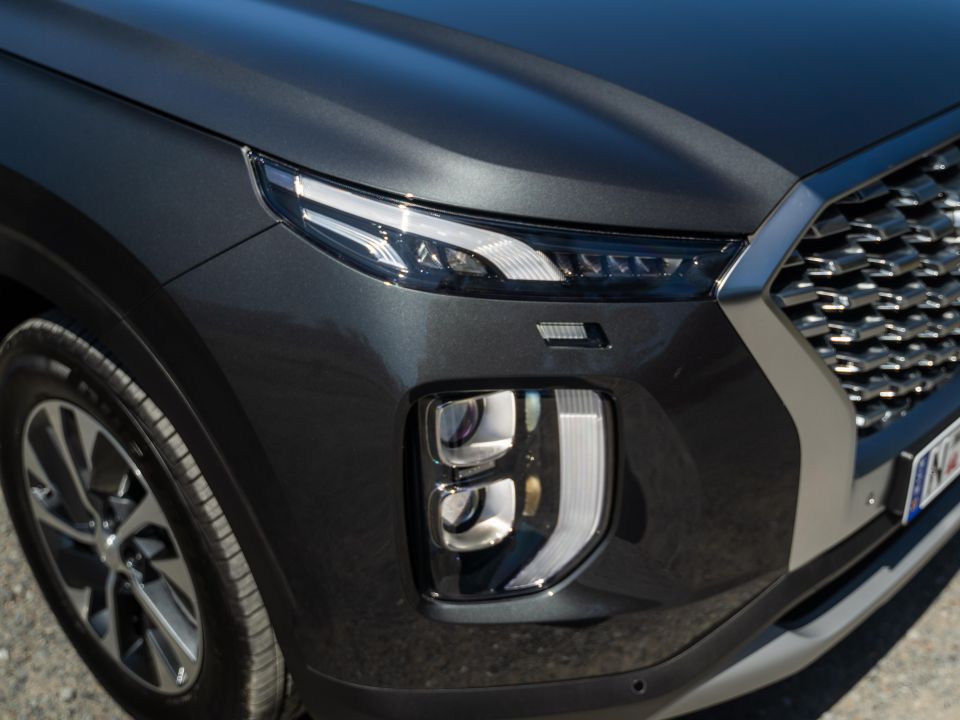
Click the images for the full gallery by Wesley Loh (@garagetribe on Instagram)
MORE: Hyundai Palisade news, reviews, comparisons and videos
Where expert car reviews meet expert car buying – CarExpert gives you trusted advice, personalised service and real savings on your next new car.
James Wong is an automotive journalist and former PR consultant, recognised among Australia’s most prolific motoring writers.


William Stopford
1 Day Ago


James Wong
4 Days Ago


Derek Fung
8 Days Ago
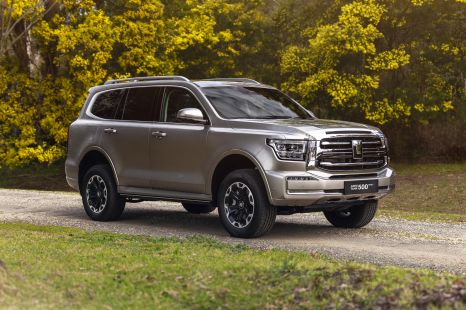

William Stopford
10 Days Ago


William Stopford
16 Days Ago


William Stopford
18 Days Ago